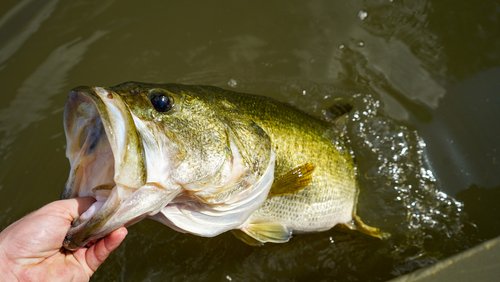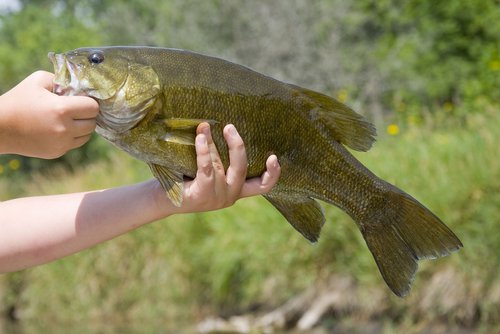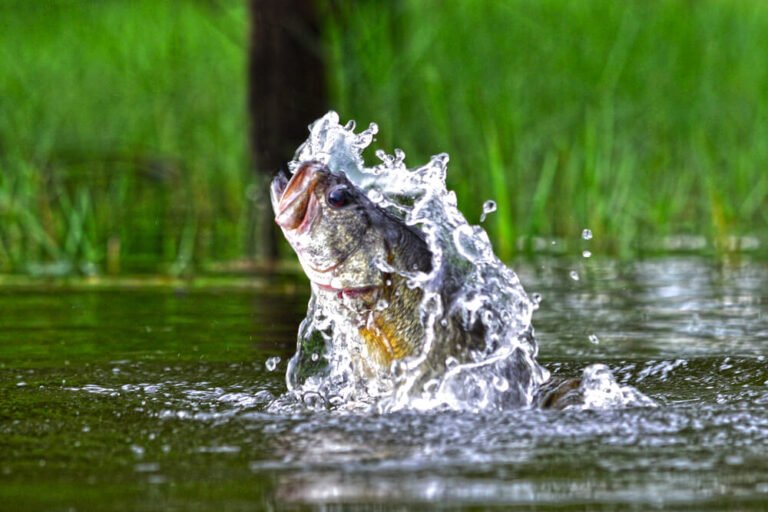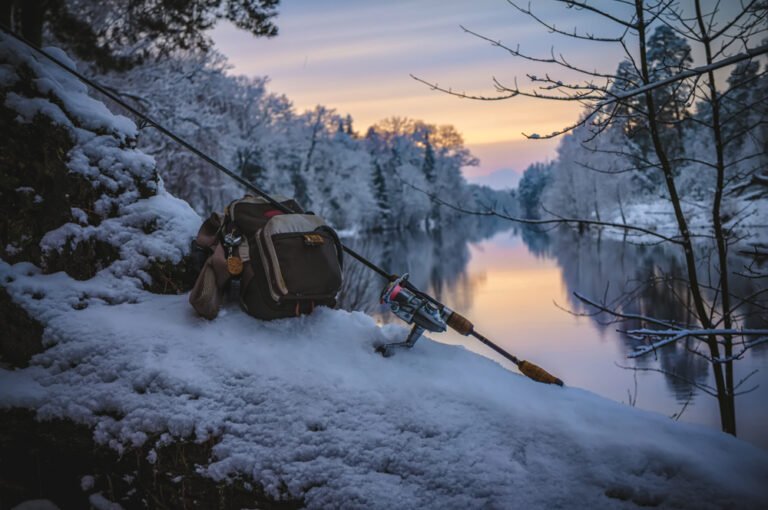Bass, a highly sought-after game fish, comprises various species with unique characteristics and preferences. The three most common bass species are the largemouth bass, smallmouth bass, and spotted bass. Let’s learn how to catch bass.
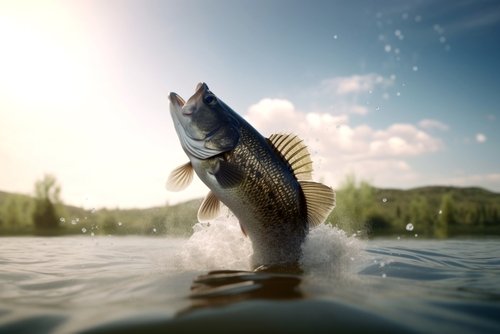
They inhabit freshwater lakes, reservoirs, and slow-moving rivers with abundant vegetation. On the other hand, smallmouth bass have a smaller mouth but are renowned for their strength and fighting ability.
They typically favor clear water areas in rocky rivers, streams, and lakes. Spotted bass share similarities with largemouth and smallmouth bass but are generally found in deeper lakes or reservoirs with submerged structures.
Preferred Habitats for Each Species
Largemouth bass thrive in environments that provide ample cover, such as aquatic vegetation like lily pads or submerged weeds where they can ambush prey. They prefer calm waters like ponds or backwaters of rivers with slow currents.
In contrast, smallmouth bass prefers cooler water temperatures than largemouth and can be found in rocky areas such as shoals or points in lakes or fast-flowing rivers. They often seek clear water conditions where their keen vision helps them locate prey more easily.
Spotted bass usually reside in reservoirs or larger impoundments that offer deep structures like ledges or drop-offs combined with rocks or brush piles.
Exploring the Structure and Cover in Their Habitats
The structure and cover within a bass’s habitat greatly influence its behavior and where anglers can successfully target it. Weeds, such as hydrilla or milfoil, provide essential cover for largemouth bass, which use them to hide and ambush prey. Additionally, submerged structures like fallen trees, stumps, or rock formations serve as ideal hiding places for bass.
Smallmouth bass gravitate towards rocky areas with boulders and gravel beds where they can find shelter and feeding opportunities. Understanding the underwater topography of a waterbody is crucial in locating prime spots where bass are likely to congregate.
Factors Affecting Bass Behavior
Several factors impact the behavior of bass, both short-term and long-term. Water temperature plays a significant role in their activity levels and feeding patterns. Bass tend to be more active in warmer water temperatures (between 60-80°F), while colder temperatures can result in sluggish behavior.
Weather conditions also influence their movements; for instance, they may retreat to deeper waters during hot summer days or become more active after rainfall when runoff brings new food sources into lakes or rivers. It’s important to consider these factors when planning fishing trips targeting specific species of bass to maximize success on the water.
Fishing Rods and Reels Suitable for Bass Fishing
When it comes to bass fishing, selecting the right fishing rod and reel combination is crucial for a successful angling experience. Two primary types of rods commonly used for bass fishing are casting and spinning rods, each offering distinct advantages depending on the fishing technique.
Different Types of Rods (Casting, Spinning) and Their Advantages/Disadvantages
Casting or baitcasting rods are designed with a reel seat on top of the rod. These rods provide anglers with excellent accuracy and control due to their ability to cast heavier lures accurately over longer distances.
They allow for precise lure placement near cover or structure where bass often hide. On the other hand, spinning rods have their reel seat positioned below the rod.
Spinning reels offer ease of use and versatility, making them an excellent choice for beginners or those who prefer finesse techniques in bass fishing. The design of spinning reels allows for smoother line release during casts and reduces line twists when using lighter baits.
Choosing the Right Reel, Gear Ratio, and Line Capacity
The reel’s gear ratio determines how often the spool turns with each full handle rotation. A moderate gear ratio ranging from 6:1 to 7:1 is typically preferred for bass fishing as it balances power and speed.
This range allows anglers to retrieve lures with enough torque to handle larger fish efficiently. Regarding line capacity, it’s important to consider the targeted species’ average size and habitat characteristics when selecting a reel.
Bass can put up a fight, requiring adequate line capacity to accommodate their strength without risking breakage or spooling out completely. Choosing a reel with a line capacity ranging from 10 to 20 pounds is recommended, depending on the fishing situation.
Different Types of Fishing Lines
Three primary fishing types are used in bass fishing: monofilament, fluorocarbon, and braided lines. Each type has its own set of characteristics that can impact your success on the water.
Monofilament lines are versatile and forgiving. They have good knot strength and offer excellent shock resistance when fighting bass.
Monofilament is also buoyant, making it suitable for topwater lures or a floating presentation. However, it does have some drawbacks, including higher visibility in clear water and lower abrasion resistance compared to other line types.
Fluorocarbon lines provide remarkable invisibility underwater due to their refractive index resembling water. This makes them ideal for situations where bass are more cautious, or the water clarity is high.
Fluorocarbon also boasts excellent abrasion resistance and sinks faster than monofilament, allowing deeper presentations with bottom baits. However, being stiffer than monofilament can make handling more challenging during casting or when using finesse techniques.
Braided lines consist of multiple synthetic fibers woven into an extremely strong, thin-diameter line. They offer a superior strength-to-diameter ratio compared to other lines with minimal stretch.
This lack of stretch enables anglers to detect subtle strikes quickly and set the hook effectively. Braided lines excel in heavy cover situations where strength is crucial but may be less suitable in clear water conditions due to their high visibility.
Selecting the Appropriate Line Strength Based on Species
Choosing the right line strength is essential for successfully landing bass while avoiding broken lines. The appropriate line strength will depend on the target species and the surrounding habitat. Most anglers opt for line strengths between 10 to 20 pounds for largemouth or smallmouth bass in freshwater environments.
However, if fishing in heavy cover with dense vegetation or around submerged structures, stronger line strengths in the 30 to 50 pounds may be necessary to prevent break-offs. When targeting spotted bass or fishing in clearer waters where fish tend to be more wary, downsizing the line strength to 6 to 10 pounds may be preferable.
It’s important to balance a strong enough line that can handle big bass and a light enough line that won’t spook them. Selecting the appropriate fishing gear is crucial for catching bass effectively.
Understanding different types of rods and reels and their advantages and disadvantages allows anglers to choose equipment suitable for their desired techniques. Additionally, comprehending various fishing lines’ characteristics and selecting an adequate line strength based on target species and habitat will significantly enhance your chances of landing that trophy-sized bass.
Lures and Baits for Bass Fishing
The right lure or bait in bass fishing is crucial for enticing these elusive creatures. Various lure categories have proven effective in enticing bass to strike. Understanding the different types of lures and their applications will greatly enhance your chances of success on the water.
Soft Plastics: Worms, Creature Baits
Soft plastics are versatile lures in various shapes, sizes, and colors. Among the most popular choices for bass anglers are worms and creature baits. Worms can be rigged Texas-style with a bullet weight or Carolina-style with a
Techniques for Catching Bass
Casting and Retrieving
Precision and timing are key when it comes to casting and retrieving techniques. Start by casting your lure near vegetation, submerged structures, or drop-offs where bass will likely hide. Once your lure hits the water, let it sink for a few seconds before starting the retrieval process. You can employ several retrieval methods, such as steady retrieve, stop-and-go retrieve, or twitching retrieve. Experiment with different speeds and pauses to imitate injured baitfish or trigger a reaction strike from the bass.
Flipping and Pitching
Flipping and pitching techniques are particularly effective when targeting bass in heavy-cover areas like dense vegetation or brush piles. With flipping, you release the line from the reel using your non-dominant hand to place the lure accurately and gently into a specific target zone. Pitching is similar but involves swinging your rod towards the target area with a more forceful motion. The goal is to present your bait near potential hiding spots while minimizing disturbances that could spook the fish.
Jigging
Jigging is an effective technique for simulating natural prey movements on the bottom of lakes or rivers where bass congregate around structures or cover. Start by selecting a jig head appropriate for the depth and structure you’re fishing in – heavier heads for deeper water and lighter ones for shallow areas. Cast out your jig near likely spots such as drop-offs or underwater ledges, allow it to sink near the bottom, then use short upward jerks followed by controlled drops of varying lengths to mimic an injured baitfish.
Conclusion
Mastering various techniques for catching bass empowers anglers with greater chances of success on their fishing expeditions. By understanding bass behavior and habitat, equipping oneself with suitable gear, selecting the right lures, and employing effective techniques like casting and retrieving, flipping and pitching, or jigging, anglers can enhance their ability to catch bass. However, fishing is a pursuit of patience and skill that requires practice and adaptability.
So, be persistent in your efforts and keep exploring new tactics to outsmart these elusive creatures of the water. Remember, each fishing trip is an opportunity to learn more about the art of bass fishing while appreciating the beauty of nature that surrounds us all.

